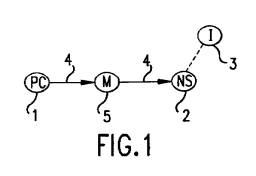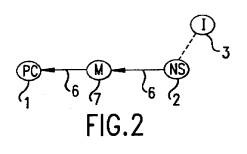

Examiner: Chirag R. Patel Art Unit: 2141
In re Application of Jed Margolin
3570 Pleasant Echo Dr.
San Jose, CA 95148-1916
Phone: 408-238-4564
Serial No. 09/947,801 Filed: 09/06/2001
For: DISTRIBUTED COMPUTING SYSTEM
Mail Stop AF
Commissioner for Patents
P.O. Box 1450
Alexandria, VA 22313-1450
Dear Sir:
Please consider the following remarks.
Pre-Appeal Brief Request for Review
Claims 1 - 5 were rejected solely under 35 U.S.C. §102(e) as being
anticipated by Ellis (US 6,167,428 Personal computer microprocessor
firewalls for internet distributed processing.
Applicantís Invention
Applicantís invention performs distributed computing using the otherwise
unused resources of a Home Network Server in a subscriber's home. The Home
Network Server has Home Network client devices such as PCs as well as sensors
and actuators used for Home Automation. An Internet connection allows the
otherwise unused resources of the Home Network Server to be used for distributed
computing by a contracting company. In return, the subscriber receives
something of value such as reduced cost of Internet service, free Internet
service, or a net payment. The advantage of using the Home Network Server
for distributed computing is that it allows the distributed computing to
be performed in a computer with a stable, robust operating system while
allowing Users to continue to use the existing operating systems and software
in their PCs. The Home Network Serverís clients are not used for distributed
computing.
Ellisí Invention
Ellis describes his invention in Column 7 lines 27 Ė 36 as follows:
DETAILED DESCRIPTION OF THE PREFERRED EMBODIMENTSThe new network computer will utilize PC's as providers of computing power to the network, not just users of network services. These connections between network and personal computer are enabled by a new form of computer/network financial structure that is rooted on the fact that economic resources being provided the network by PC owners (or leaser) are similar in value to those being provided by the network provider providing connectivity.
Issues
The main issues in dispute are:
1. The Examiner erroneously asserts that the Network Server (2) shown in Ellis is the same as the Home Network Server (101) used by Applicant and performs the same function.Since these errors made by the Examiners show a lack of understanding of the essence of Ellisí invention and/or Applicantís invention no discussion of Applicantís claims was possible.2. The Examiner erroneously defines the term subscriber in a way that is not consistent with Applicantís use of the term, denying Applicant the right to act as his own lexicographer even if it is to use the ordinary meaning of the term.
3. The Examinerís supervisor erroneously denies Applicant the right to act as his own lexicographer even if it is to use the ordinary meaning of the term home.
Detailed Discussion
1. The Examiner erroneously
asserts that the Network Server (2) shown in Ellis is the same as the Home
Network Server (101) used by Applicant and performs the same function.
Applicant believes Applicantís Home Network Server has already been sufficiently characterized above in Applicantís Invention.
The Network Server NS2 shown by Ellis in numerous figures is part of the ISPís equipment. In the interests of brevity two will be discussed. From Ellis Column 6 BRIEF DESCRIPTION OF THE DRAWINGS:
FIG. 1 is a simplified diagram of a section of a computer network, such as the Internet, showing an embodiment of a meter means which measures flow of computing during a shared operation such as parallel processing between a typical PC user and a network provider.FIG. 2 is a simplified diagram of a section of a computer network, such as the Internet, showing an embodiment of another meter means which measures the flow of network resources, including shared processing, being provided to a typical PC user and a network provider.
Ellis Figures 1 and 2 are reproduced
below:


In Ellis Figure 1, Meter M5 is located between PC1 and Network Server NS2 and in Ellis Figure 2 Meter M7 is located between PC1 and Network Server NS2. According to Ellis, it is the computing resources of PC1 that are used for distributed computing for which Ellis receives payment of one kind or another. Network Server NS2 is part of the ISPís equipment and is therefore not a Home Network Server 101 as taught by Applicant. If Ellisí Network Server NS2 were the same as Applicantís Home Network Server 101, then Ellisís financial arrangement would be with himself. This interpretation would render Ellisí patent invalid for lack of usefulness. Since issued patents are presumed valid such an interpretation is impermissible. However, it is clear that Ellis intends his financial arrangement to be with a separate party. From Column 10 lines 1-6:
The financial basis of the shared use between owners/leasers and providers would be whatever terms to which the parties agree, subject to governing laws, regulations, or rules, including payment from either party to the other based on periodic measurement of net use or provision of processing power
Also, since Ellisí Network Server NS2
is part of the ISPís equipment, if the resources of NS2 were used for distributed
computing then Ellisí ISP would be paying him for using their own equipment.
The Examinerís insistence that Ellis shows
a Home Network Server extends to erroneously referring to Ellisí Network
Server (NS2) as Home Network Server (2), a term that Ellis
himself never uses. See Second Office Action of 6/15/2005 page 2, Rejection
2, and Examinerís Summary of Telephone Interview held 08/09/2005 where
the Examiner states (page 3, top of page): Examiner pointed out Ellisís
home network server is the same as applicantís invention in that it provides
a connection to the internet and one or more home network client devices
that participates in the shared computer processing. In addition
to erroneously referring to Ellisí Network Server (2) as a home network
server, the Examiner makes the statement that Applicantís home network
serverís client devices participate in the shared computer processing.
Applicant has always asserted that his distributed computing arrangement
is for the use of the Home Network Serverís resources, and that one of
the advantages of this arrangement is that the client devices are not used
for distributed computing. (Note: Applicant does not believe the Examiner
actually made this statement during the interview as reported in Examinerís
Summary.)
2. The Examiner erroneously defines the term subscriber in a way that is not consistent with Applicantís use of the term, denying Applicant the right to act as his own lexicographer even if it is to use the ordinary meaning of the term.
In the Second Office Action of 6/15/2005 (page 2, Section 1 last line), The Examiner states "When a device receives a service, is interpreted by the examiner to mean "subscribing" to a service." This interpretation is not supported by Applicantís use of the term. Applicant used the common meaning of the term. From the online version of the American Heritage ® Dictionary of the English Language, Fourth Edition at http://www.yourdictionary.com/ahd/s/s0850100.html :
sub·scribe Listen: [ sb-skrb ]
v. sub·scribed, sub·scrib·ing, sub·scribes
v. tr.
1. To pledge or contribute (a sum of money).
2. To sign (one's name) at the end of a document.
3. To sign one's name to in attestation, testimony, or consent: subscribe a will.
4. To authorize (someone) to receive or access electronic texts or services, especially over the Internet.v. intr.
1. a. To contract to receive and pay for a certain number of issues of a publication, for tickets to a series of events or performances, or for a utility service, for example. b. To receive or be allowed to access electronic texts or services by subscription.
2. To promise to pay or contribute money: subscribe to a charity.
3. To feel or express hearty approval: I subscribe to your opinion. See Synonyms at assent.
4. To sign one's name.
5. To affix one's signature to a document as a witness or to show consent.[Middle English subscriben, to sign, from Latin subscrbere : sub-, sub- + scrbere, to write; see skrbh- in Indo-European roots.] sub·scriber n.
All of these definitions imply that
the subscriber is a person. In all of the instances in the present application
it is clear from the context that the subscriber is a person, nominally
the owner of the Home Network. For example, from paragraph 0016 of the
present Application:
[0016] In exchange for the use of the otherwise unused capacity of the Home Network Server for distributed computing, the contracting company provides the subscriber (nominally the owner of the Home Network) something of value such as reduced cost of Internet service, free Internet service, or a net payment.
The subscriber is a person. Applicantís
devices are not persons and are therefore not subscribers.
3. The Examinerís supervisor erroneously denies Applicant the right to act as his own lexicographer even if it is to use the ordinary meaning of the term home.
During the Telephone Interview of August
25, 2005, in an attempt to discuss the everyday meaning of common terms,
Applicant thought the word home would be good place to start.
Applicant was wrong. The Examinerís supervisor asserted that he considers
his office at the Patent Office his home even though he owns
a house. Realizing that the Examinerís supervisor was being ironic, disingenuous,
or was literally living in his office at the Patent Office, Applicant determined
that the Examinerís supervisor was not serious about advancing the case.
Therefore, since Ellis does not teach a Home Network Server in a subscriberís
home and since the otherwise unused resources of Ellisí Network Server
2 are not used for distributed computing in return for something of value
from a contracting company, as well as for other good reasons omitted for
the purpose of brevity, Applicant believes all rejections have been traversed
and requests the Application be allowed as filed.
Respectfully submitted,
Jed Margolin
pro se inventor
September 6, 2005
______________________________________________________________________
I hereby certify that this correspondence is being deposited with the U.S. Postal Service with sufficient postage as first class mail in an envelope addressed to: Commissioner for Patents, P.O. Box 1450 Alexandria, VA 22313-1450 on the date shown below.
Date: September 6, 2005
Inventor's Signature:
_____________________________________